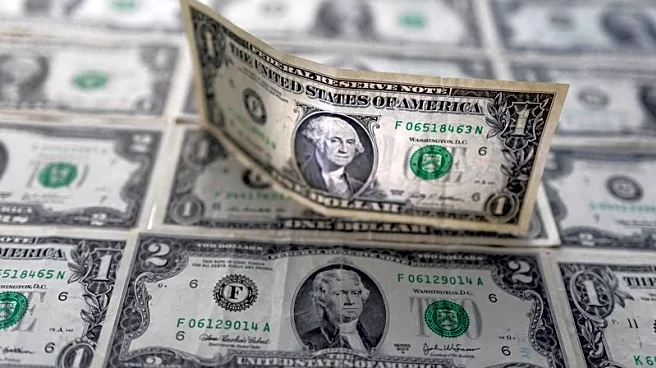What's Happening?
The Federal Reserve has indicated that a December rate cut is not guaranteed, following a recent 25 basis point reduction. This announcement comes as gold prices experience volatility, with spot gold rising
over 1% to approximately $3,984 per ounce. The increase in gold prices is attributed to a risk-off sentiment among investors, who are moving away from risk assets. The ADP National Employment Report showed an increase of 42,000 private-sector jobs in October, surpassing expectations and influencing rate-cut odds. Despite this, safe-haven flows into gold remain strong, driven by broader equity market concerns and a firming U.S. dollar. The gold market has seen significant activity, with increased open interest and trading volumes on COMEX, suggesting renewed investor interest.
Why It's Important?
The Federal Reserve's cautious stance on further rate cuts has significant implications for the U.S. economy and financial markets. A potential pause in rate cuts could affect borrowing costs, consumer spending, and investment decisions. The rise in gold prices reflects investor uncertainty and a preference for safe-haven assets amid economic ambiguity. This trend could impact sectors reliant on consumer confidence and spending, such as retail and real estate. Additionally, the employment data from ADP highlights ongoing labor market resilience, which may influence future monetary policy decisions. The interplay between interest rates, gold prices, and employment figures underscores the complex dynamics facing policymakers and investors.
What's Next?
Investors and market analysts will closely monitor upcoming economic data releases, particularly those affected by the federal government shutdown, to gauge the Federal Reserve's next moves. The Fed's communication and any hints regarding future rate adjustments will be pivotal in shaping market expectations. Additionally, the performance of gold and other precious metals will be watched as indicators of investor sentiment and economic stability. The ongoing analysis of ETF flows and central bank activities will provide insights into long-term trends in the gold market.
Beyond the Headlines
The current economic environment raises questions about the sustainability of the U.S. economic recovery and the effectiveness of monetary policy in addressing inflation and growth challenges. The reliance on private sector reports due to the government shutdown highlights vulnerabilities in data-driven decision-making. Furthermore, the fluctuating gold prices may signal broader concerns about global economic stability and geopolitical tensions, influencing investor behavior and market dynamics.












